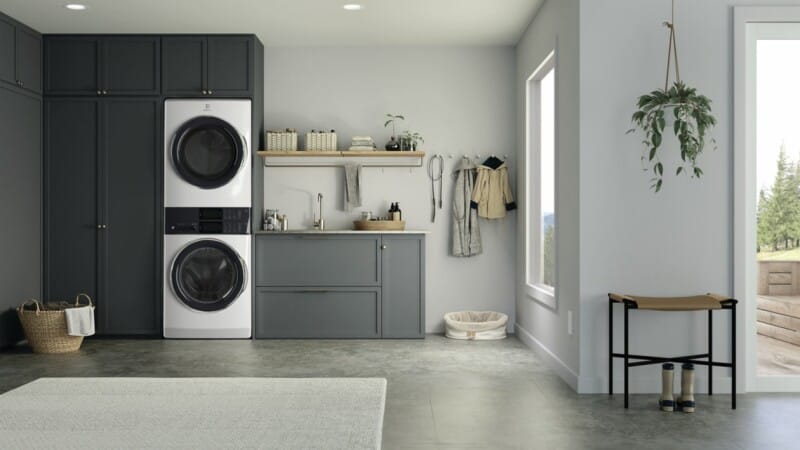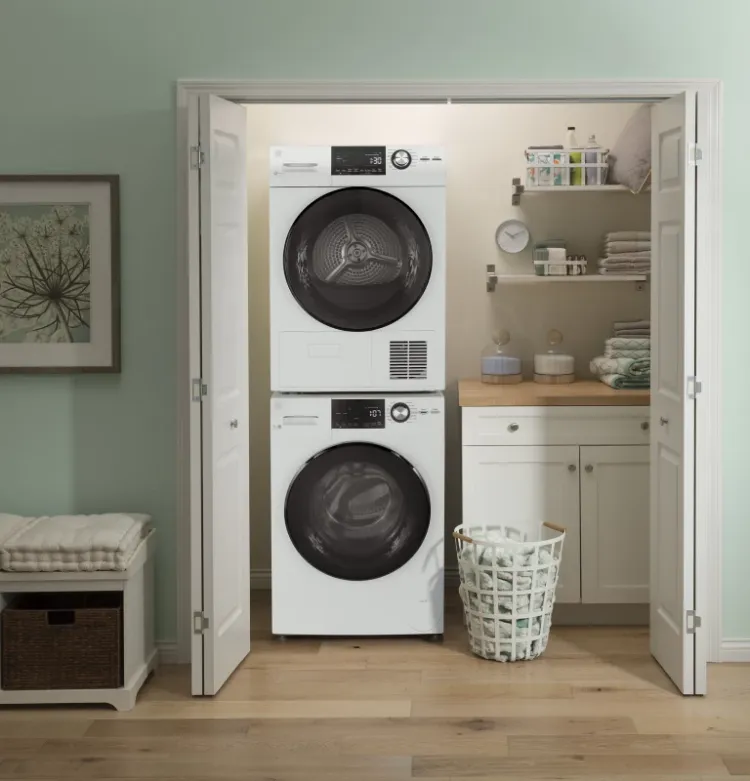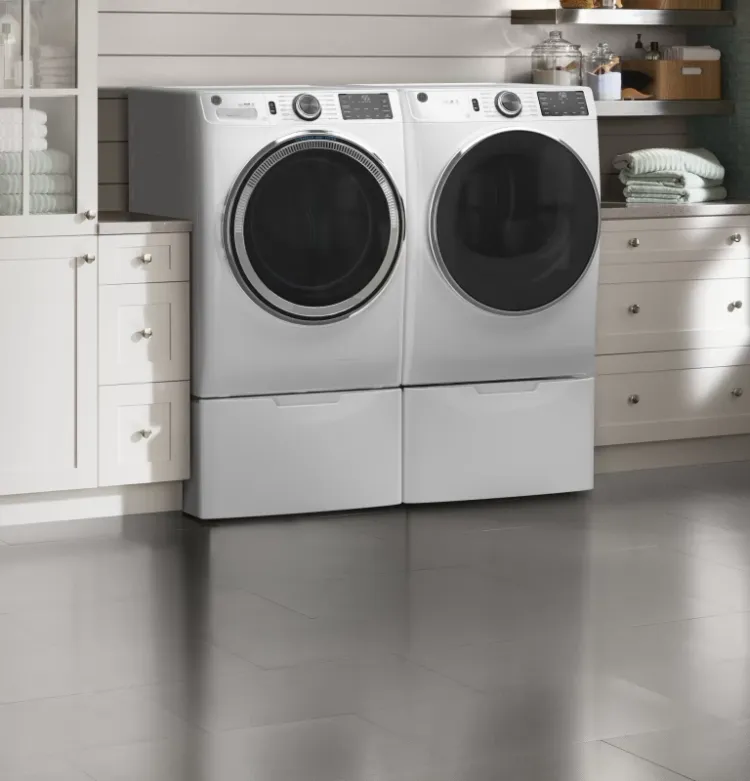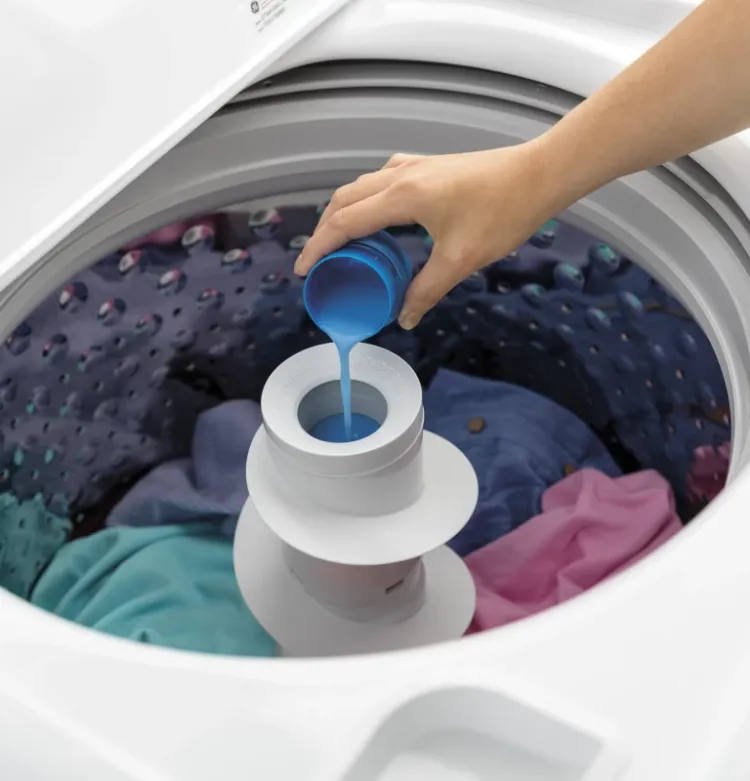Advantages and Disadvantages of a Stacking Washer and Dryer

When it comes to modern laundry solutions, stacking washers and dryers have become increasingly popular, especially for homeowners dealing with limited space. These vertical laundry units offer a compact and efficient way to tackle your laundry needs while maximizing floor space. But like any appliance, stacking washers and dryers come with their own set of advantages and disadvantages.
Whether you're renovating a small apartment or looking to optimize your laundry room, understanding the pros and cons of stackable laundry units is crucial. This guide will walk you through everything you need to know about stacking washers and dryers, helping you decide if this space-saving solution is the right fit for your home.
What is a Stacking Washer and Dryer?
A stacking washer and dryer, also known as a stackable laundry unit, is a vertical arrangement of a washer and dryer that maximizes floor space in your laundry area. This compact laundry solution typically consists of two separate appliances: a front-load washer on the bottom and a dryer stacked on top.
There are two main types of stackable units:
Separate Stacking Units: These are individual washers and dryers designed to be stacked using a special stacking kit. This option offers flexibility, as you can use them side-by-side if you later move to a space with different dimensions.
All-in-One Stackable Systems: These are single, integrated units that combine both washer and dryer functions in one appliance. While less common, they can be an ultra-compact solution for very tight spaces.
Typically, stackable washers and dryers are narrower than traditional side-by-side models. The average dimensions for a stacking washer and dryer setup are around 27 inches wide, 30-35 inches deep, and 70-80 inches tall. However, compact models designed for small apartment laundry setups can be as narrow as 24 inches.
Advantages of a Stacking Washer and Dryer
Stacking washers and dryers offer several benefits that make them an attractive option for many homeowners. Let's explore the key advantages:
1. Space-Saving Design
The most significant benefit of a stackable washer and dryer is its space-saving capability. By utilizing vertical space, these units free up valuable floor area in your laundry room or small apartment. This efficient use of space allows for additional storage or other purposes, making it an ideal laundry room optimization solution.
2. Energy Efficiency
Many stackable units, particularly those with front-load washers, are designed with energy efficiency in mind. These energy-efficient laundry units often come with high Energy Star ratings, which can lead to lower utility bills over time. Front-load washers typically use less water and electricity compared to their top-load counterparts, contributing to both cost savings and environmental benefits.
3. Ergonomic Benefits
Stackable units with front-load washers offer ergonomic advantages. The design reduces the need to bend over excessively when loading or unloading laundry, making it easier on your back compared to top-load washers. This ergonomic washer and dryer setup can be particularly beneficial for those with mobility issues or back problems.
4. Modern Features
Many stackable washer and dryer models come equipped with advanced features that enhance convenience and performance. These may include:
- Smart connectivity for remote operation and monitoring
- Steam functions for better stain removal and wrinkle reduction
- Customizable cycles to suit different fabric types and soil levels
- Quiet operation, ideal for units placed near living areas
5. Versatility in Placement
While primarily designed for stacking, many of these units can also be used side-by-side if needed. This flexibility allows you to adapt your laundry setup based on changing space constraints or preferences, making them a versatile choice for various home layouts.
6. Aesthetic Appeal
Stackable units often have a sleek, modern appearance that can enhance the look of your laundry area. Their compact design and clean lines contribute to a more organized and visually appealing laundry space, fitting well with modern laundry room design trends.
These advantages make stacking washers and dryers an attractive option, especially for those dealing with limited space or looking to modernize their laundry routine. However, it's important to weigh these benefits against potential drawbacks, which we'll explore in the next section.
Disadvantages of a Stacking Washer and Dryer
While stackable washers and dryers offer numerous benefits, it's important to consider their potential drawbacks before making a decision. Here are the main disadvantages to keep in mind:
1. Higher Upfront Cost
Stackable washer and dryer units often come with a higher price tag compared to traditional models. This increased cost of stackable washer and dryer sets is due to their specialized design and advanced features. Additionally, you may need to factor in the cost of a stacking kit and potentially higher installation expenses, especially if modifications to your laundry space are required.
2. Limited Capacity
One of the trade-offs for the space-saving design is a typically smaller drum size in both the washer and dryer. This limited capacity stackable laundry setup might be challenging for larger families or those who frequently wash bulky items like comforters. You may find yourself doing more frequent loads to compensate for the reduced capacity.
3. Increased Maintenance
Front-load washers, which are common in stackable units, are more prone to mold and mildew buildup around the door seal. This issue requires more frequent cleaning and maintenance to prevent odors and ensure proper hygiene. Regular cleaning of the rubber gasket and leaving the door open between uses can help mitigate this problem.
4. Accessibility Issues
The vertical arrangement of stackable units can create accessibility challenges, particularly for shorter individuals or those with mobility issues. Reaching the controls or loading/unloading the dryer when it's positioned on top might be difficult without a step stool. This aspect of the ergonomic washer and dryer setup should be carefully considered based on the users' needs.
5. Compatibility and Replacement Challenges
When it comes time to replace one of the units, you may face compatibility issues. Not all washers and dryers are designed to be stacked, and finding a replacement that fits perfectly with your existing unit can be challenging. This can potentially lead to higher replacement costs if both units need to be replaced simultaneously.
6. Potential for Vibration and Noise
Stacked units, especially when not properly installed, can be prone to more vibration and noise compared to side-by-side models. This can be particularly noticeable during spin cycles. Proper installation and use of anti-vibration pads can help, but it's something to consider, especially if your laundry area is near living spaces.
7. Limited Options
While the market for stackable units has grown, you may still find fewer options compared to traditional washers and dryers. This could limit your choices in terms of features, colors, or specific functionalities you might be looking for.
Key Considerations Before Choosing a Stackable Washer and Dryer
Space Requirement
Carefully measure your available space, considering both height and width. Account for ventilation needs and clearances specified by the manufacturer. Ensure there's enough room for comfortable loading and unloading, including door swing space.
Compatibility
Verify that the washer and dryer models you're considering are designed to be stacked. Check if a stacking kit is included or needs to be purchased separately. Using the correct washer and dryer stacking kits is crucial for safety and proper functioning.
Capacity Needs
Evaluate your typical laundry volume and frequency. While stackable units generally have smaller capacities, some models offer larger drums suitable for families. Consider how often you're willing to do laundry, as more frequent, smaller loads might be necessary.
Frequently Asked Questions (FAQs)
Are all front-load washers and dryers stackable?
Not all front-load washers and dryers are stackable. While many are designed with this capability, it's essential to check the manufacturer's specifications. Always use models that are explicitly designed to be stacked and ensure you have the correct stacking kit.
What is the average lifespan of a stackable washer and dryer?
The average lifespan of a stackable washer and dryer is similar to traditional units, typically ranging from 10 to 15 years. However, proper maintenance and usage can extend their life. Regular cleaning and avoiding overloading can contribute to longevity.
Can you unstack a stackable washer and dryer?
Yes, you can unstack a stackable washer and dryer if they're separate units. This flexibility allows you to adapt to different living situations. However, ensure you have the space to place them side by side and that they're designed to function independently.
How do I clean and maintain my stackable washer and dryer?
Regular maintenance and cleaning your washer is crucial. Clean the washer's rubber gasket after each use to prevent mold. Run monthly cleaning cycles with a washer cleaner. For the dryer, clean the lint filter after each use and periodically check and clean the vent duct.
Do stackable units have the same features as full-size models?
Many stackable units offer similar features to full-size models, including various wash cycles, steam functions, and smart connectivity. However, due to size constraints, some may have slightly fewer options or smaller capacities.
How much space do I need for a stackable washer and dryer?
Typically, you'll need a space about 27-30 inches wide, 32-35 inches deep, and 70-80 inches tall. However, always check the specific dimensions of the model you're considering and allow for additional space for ventilation and connections.
Are Stackable Washers Right For Your Home?
Choosing between a stacking washer and dryer and traditional laundry appliances ultimately depends on your specific needs, space constraints, and lifestyle. These vertical laundry units offer significant advantages in terms of space-saving and modern features, making them an excellent choice for small apartments, compact laundry rooms, or those looking to optimize their living space.
Remember, the best stackable washer and dryer for your home is one that balances efficiency, functionality, and your specific requirements. Whether you opt for a stackable unit or stick with traditional side-by-side appliances, investing in quality machines and maintaining them properly will ensure you get the most out of your laundry setup for years to come.



